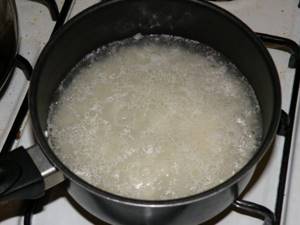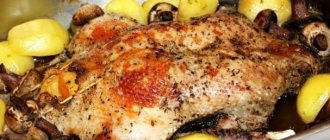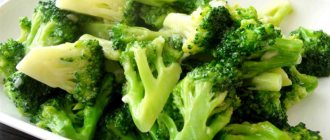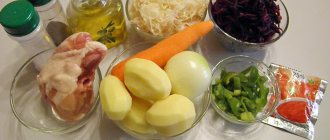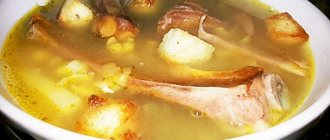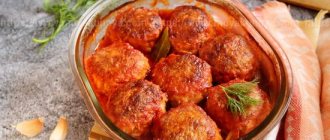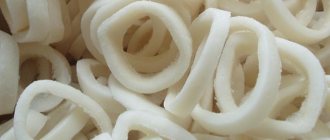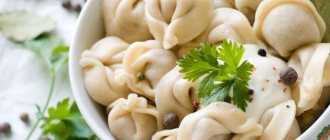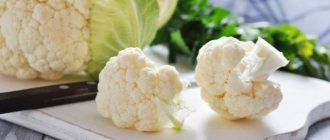Sticky Rice - Do you love it as much as I do? Perhaps, in the “sticky” version, I like this cereal much more than in the crumbly version - I just love it so much! To such an extent that I can eat it non-stop - for breakfast, lunch and dinner, instead of a snack and as a dessert. Most often, of course, the request for how to cook sticky rice is associated with the desire to make sushi or rolls - it is these Japanese dishes that require sticky grains that are held in place by one ball (or not by a ball - but by the shape that you decide to give it) however, it is prepared in exactly the same way for onigiri (the famous fast food - “triangles” with filling, which seems to be half of Japan’s lunch), yakionigiri (fried rice), mochi (a type of rice dough) and much more. In addition, sticky rice is a common side dish and even a completely independent dish, which, in the company of fried sesame seeds, crushed nori and other seasonings, is quite suitable for a full dinner. In my universe, it definitely works and even often performs. It is convenient to take sticky rice with chopsticks, however, as you understand, the fork we are all familiar with will also cope with the task quite well.
Stubborn statistics say that about 700 million tons of rice are eaten annually in the world - in order to meet such needs of mankind, approximately 1 billion people, that is, every sixth inhabitant of our planet, are involved in growing and cultivating the fields.
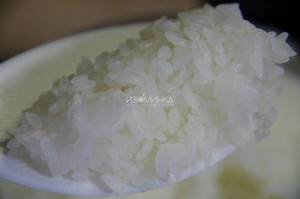
To make sticky rice you need round grains; in Japan they use the japonica variety; at home I just buy good quality round rice. Not ideal, but it suits me. The price-quality ratio is optimal. In general, this is the best that I can offer myself in non-Japanese conditions, however, if you are ready to buy rice at a price close to the cost of pollen from flowers on which sat a butterfly that flew out of the hair of a rainbow unicorn, you can look in supermarkets for what you need on shelves with goods for making sushi.
Instructions
- We measure out the amount of rice you need.
- Very good, perfectly washed - the Japanese say that rice needs to be “washed”. The water should be completely clear.
- The second name for the process is “polishing”: thanks to it, the rice becomes smooth, translucent, beautiful.
- Friends who taught me how to cook rice say that rinsing it in 3-4 waters is quite enough, but my practice shows that with the rice that I buy, I have to play with it an order of magnitude more - I rinse it at least 10 times.
- After this, fill the rice with cold water so that there is 1 knuckle of water more than the rice. Leave for 1 hour.
- After this time, put the pan on the fire.
- Bring to a boil, reduce the heat to medium and cook under a lid (transparent is the best) until the water has almost completely evaporated or until grains of rice sound like they are bursting (or until small craters appear - pay attention to the photo).
- Reduce heat to low and cook for another 10 minutes.
- After this, turn off the gas and let the rice stand under the lid for another 10 minutes.
- Sticky rice is ready.
- You can immediately put it on plates, you can pack the excess in cling film and store it in the freezer - then take it out as needed, defrost it and treat yourself.
- Bon appetit!
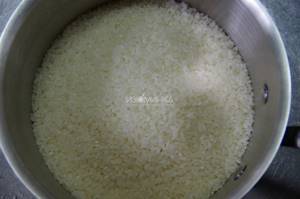
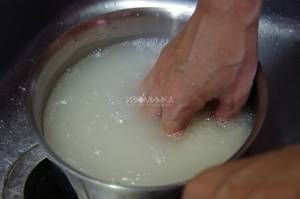
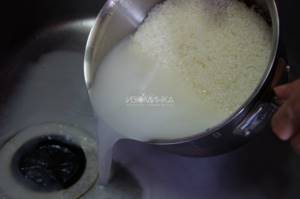
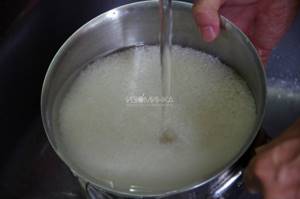
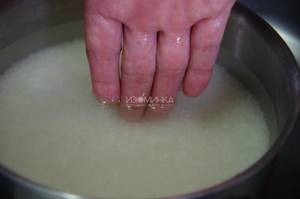
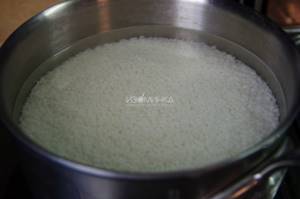
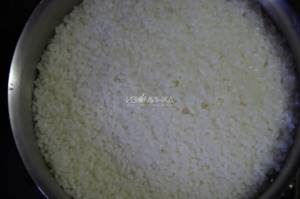

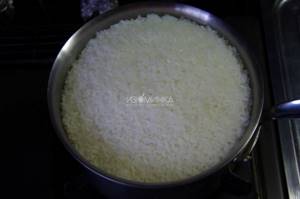
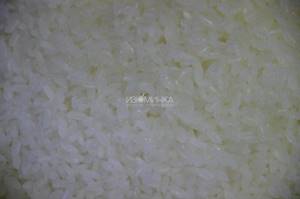
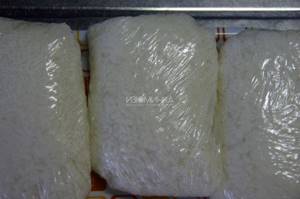
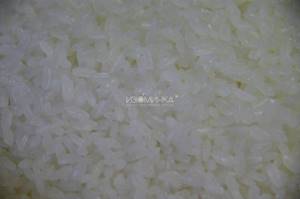
Rice is sticky and too watery: correcting common mistakes
If the rice burns
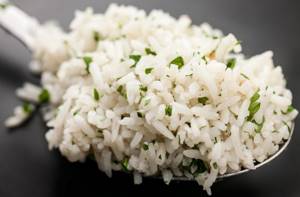
Burning rice is quite easy, especially if you cook it over a fire. This can happen for several reasons, the most common of which is failure to keep the water and grains in the pan. And our usual “2:1” more often turns out to be an erroneous opinion. It is necessary to take 300 cm3 of water per 200 cm3 of rice, that is, the ratio will ultimately be 1.5:1. You need to pour boiling water over the rice or pour the cereal into boiling water to eliminate the time required to bring the water to a boil, which will be different for different stoves, and we will not be able to accurately calculate the cooking time for each specific case. If it's undercooked
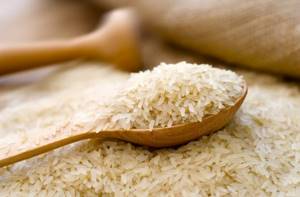
Maybe you cooked it at too high a temperature, boiling off all the water. In any case, a glass of hot water and another five to ten minutes of cooking will not hurt. You need to cook rice in a saucepan with a tight-fitting lid to prevent steam from escaping completely from the pan, which should go into cooking the rice. The classic recipe by William Pokhlebkin says that the cooking time for rice should be exactly 12 minutes, no more and no less. Cook on high heat for 3 minutes, on medium for 7 minutes and on low for the last 2 minutes. Next, turn off the heat and leave the rice on the stove, covered, for 12 minutes. Do not open the lid until this time is over. After 12 minutes, open the lid, add salt and season with oil (20-25 g). If he's in the water
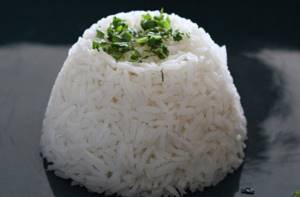
The rice is already cooked, but there is still enough water left at the bottom? In this situation, you can choose two strategies - either evaporate the water on a large burner or strain the rice through a sieve. If it sticks together
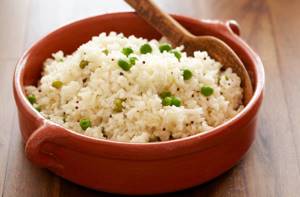
Rice cooked in lumps does not become less tasty, but it is no longer as pleasing to the eye. The most common mistake rice cooks make is that they often stir the rice, which turns it into porridge. You only need to stir the rice once when it boils. It is not recommended to do this during further cooking. This way the rice takes the required position and does not absorb excess water. The exception is risotto: when preparing Italian risotto, rice, on the contrary, is often stirred during cooking. But the liquid is not added there all at once, but in parts. If you rinse rice
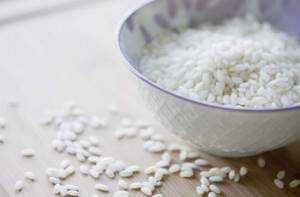
Whatever rice you use to make sushi: special or regular short-grain rice, you need to rinse it well with cold running water until it becomes transparent. All floating grains of rice must be removed - according to Japanese rules, only “bad” rice floats in the water and should be thrown away. Of course, when washing rice, you also need to remove all debris, all dark grains of rice. But rinsing rice after cooking is not a good idea. If you are frying rice
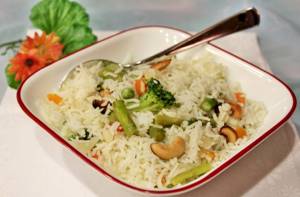
There is a sautéing method, with which you can get better quality rice by first frying the dry cereal in a frying pan with oil. The cereals are sorted, washed in cold water, then in hot water; put in a colander or sieve and put in a bowl with heated fat and heat until the moisture evaporates, then boiling water or broth is poured into the bowl with the cereal so that the cereal immediately boils, and bring to readiness. This is how rice for side dishes is prepared. Source: steaklovers.menu
How long does it take for foods to be digested?
Digestion time is also highly individual.
To feel light and active, a person must improve digestion. Each type of food is given an individual time limit for digestion. The stomach digests one product faster, and another longer. That is why knowing the digestion time of foods and learning how to use them correctly is very important. Attached below is a table with the time period of food in the human stomach.
Vegetables and fruits
| Fruit | Type | Processing time, min. |
| Fruits | Watermelon | 20 |
| Orange | 30 | |
| Mandarin | ||
| Kiwi | ||
| Grape | ||
| Grapefruit | ||
| Peach | 40 | |
| Apricot | ||
| Plum | ||
| Melon | ||
| Apple | ||
| Cherry | ||
| Banana | 60 | |
| Figs | ||
| Dates | ||
| Vegetables | bell pepper | Raw - 30-40 |
| Tomato | ||
| Cucumber | ||
| Celery | Boiled - 40-55 | |
| Lettuce leaves | ||
| Corn | 45 | |
| Cauliflower | ||
| Broccoli | ||
| Zucchini | ||
| Potato | 60 | |
| Pumpkin | ||
| Carrot | 50 | |
| Beet | ||
| Turnip |
Fresh and sauerkraut, as well as avocados, take an average of 3-4 hours to digest.
Meat and fish
Other products
| Product | Type | Processing time, hours |
| Cereals | Brown rice | 1,5 |
| Buckwheat | ||
| Millet | ||
| Oatmeal | ||
| Nuts | Peanut | 2,5-3 |
| Gretsky | ||
| Almond | ||
| Forest | ||
| Egg | yolk | 0,5 |
| fully | 0,5 | |
| Dairy | Skimmed milk | 1,5 |
| Low-fat cottage cheese | ||
| Whey cheese | ||
| Cottage cheese made from full fat milk | 1,5 | |
| Hard cheese | 4-5 | |
| Ryazhenka | 1 | |
| Flour products | Pasta | 3 |
| Bread, buns | ||
| Seeds | Sunflower, pumpkin | 2 hours |
| Sesame | ||
| Sweets | Pure chocolate | 2 hours |
| Chocolate with raisins and nuts | 2,5 | |
| Honey | 1,5 | |
| Ice cream | 4 |
)
DIGESTION TIME FOR DIFFERENT FOODS
(approximate time spent in the stomach before passing on)
Water
if the stomach is empty, it passes immediately into the intestines
Juices
fruits and vegetables, vegetable broth - 15-20 minutes Semi-liquid (mashed salad, vegetables or fruits) - 20-30 minutes
Fruits
Watermelon - 20 minutes Melons - 30 minutes Oranges, grapefruits, grapes - 30 minutes Apples, pears, peaches, cherries, etc. - 40 minutes
Vegetables
Raw mixed vegetable salads - tomatoes, lettuce, cucumber, celery, green or red pepper, other juicy vegetables - 30-40 minutes
Boiled, stewed or steamed vegetables
Leafy vegetables - spinach, endive, kale - 40 minutes Zucchini, broccoli, cauliflower, green beans, pumpkin, corn on the cob - 45 minutes Root vegetables - carrots, beets, parsnips, turnips, etc. — 50 minutes
Semi-concentrated carbohydrates - starches
Jerusalem artichoke, acorns, corn, potatoes, Jerusalem artichoke, yams, chestnuts - 60 minutes
Concentrated carbohydrates - cereals
Brown rice, millet, buckwheat, corn flakes, oats (the first 3 are best) - 90 minutes
Beans and Legumes (Concentrated Carbohydrates and Protein)
Lentils, lima beans, chickpeas, peas, beans and beans - 90 minutes Soybeans - 120 minutes
Nuts and seeds
Seeds – sunflower, pumpkin, pepita, sesame – about 2 hours Nuts – almonds, filberts, peanuts (raw), cashews, Brazil nuts, walnuts, pecans – 2.5-3 hours
Dairy
Skim milk, ricotta, low-fat cottage cheese or cream cheese - about 90 minutes Whole milk cottage cheese - 120 minutes Hard whole milk cheese - 4-5 hours
Animal proteins
Egg yolk - 30 minutes Egg (whole) - 45 minutes Fish - cod, scrod, flounder, sole seafood - 30 minutes Fish - salmon, trout, herring, fattier fish - 45-60 minutes Chicken - 1-2 hours (without skin ) Turkey - 2 hours (without skin) Beef, lamb - 3-4 hours Pork - 4-5 hours
Editor's Notes
:
1: Raw animal proteins are digested in a shorter time than that stated above for cooked/heated animal fats.
approx.
2: These digestion times are based on an ideal situation where you eat one food at a time, chew well, and have your digestive tract working efficiently, such as after fasting. This is the digestion time for an optimally healthy person with healthy eating behavior. Much of this data comes from the work of Dr. Gian-Curcio and Dr. Bass. Digestion time for a normal diet, for people with suboptimal digestion who have little energy, and for dishes mixed with a large number of ingredients (not assembled in the correct order) is much longer.
To eat properly, you need to know not only the number of calories in food,
but also the time it takes to digest a particular product,
so as not to burden the stomach with a meaningless load in the form of some apple eaten between lunch and dinner.
Fast-digesting foods give a person quick energy, while slowly digested foods provide a long-lasting feeling of fullness.
Everything that is not included in the digestion time described below takes even longer to digest.
1 hour 15 minutes Parsley
1 hour 30 minutes Lemon Sea kale
1 hour 45 minutes Avocado Grapes Mango Olives Raspberries
2 hours Blueberries Cherries Grapefruit Oranges Raisins Coconut milk Artichokes Garlic Potatoes Tomatoes Brown rice
2 hours 15 minutes Fresh figs Pear Pineapple Strawberries Asparagus Carrots Cabbage Salads: lettuce, cabbage, etc.
2 hours 30 minutes Dates Dried figs Gooseberries Fresh peach Almonds Dandelions Greens Leeks Mushrooms Beans Beans White rice Basmati rice
2 hours 45 minutes Fresh apples Fresh apricots Currants Dried apricots Prunes Watermelon Chestnuts Fresh coconut flesh Pecans Pine nuts Beetroot Zucchini Wheat bran
3 hours Lime Dried prunes Hazelnuts Walnuts Broccoli Cabbage Swiss chard Sweet corn Chicory Kohlrabi Rhubarb Spinach White beans Lentils Soybeans Wheat germs
3 hours 15 minutes Cranberries Cantaloupe Torpedo melon Olive oil Pomegranate Cashews Dried coconut Celery Cucumbers Onions Sweet green peppers Pumpkin Radish Rutabagas Sweet potatoes Turnips Fresh peas Peanuts Millet
3 hours 30 minutes Sesame oil Eggplant Mustard Dried peas Soybean oil Rye
3 hours 45 minutes Persimmon Quince Red cabbage Barley Wheat
4 hours Brussels sprouts Horseradish
Healthy products that deserve more attention.
There are a number of products that we rarely or never buy.
Let us at least remember those vegetables and fruits that our mothers and fathers forced us to eat, but we stubbornly refused. It's a pity! They help improve your health without a doctor's prescription. The benefits of such products have been proven by many years of use, and some - literally for centuries. First on the list is kiwi. This exotic fruit has become a regular guest on our shelves in recent years. One kiwi a day covers the daily requirement of vitamin C, which is known to strengthen the immune system, blood vessels, increase the body's resistance to all kinds of infections, and help the body fight stress. In addition, kiwi contains a lot of magnesium, potassium mineral salts and fiber, which helps remove cholesterol from the body and normalizes digestion. The second useful product is cranberry. This berry is indispensable for colds - it has an antipyretic effect, kills viruses in acute respiratory infections. The use of these healing berries lowers blood pressure in hypertensive patients, strengthens the gums, and enhances the secretory activity of the pancreas. Raisins are a tasty and nutritious product with many beneficial properties. Raisins have a strengthening effect on the nervous system, help suppress anger, and strengthen the heart. Raisins contain substances that stop the growth of bacteria that cause tooth decay and gum disease.
Our list ends with broccoli. It is an excellent supplier of vitamins C, PP, K, U and beta-carotene. There is almost 2.5 times more ascorbic acid (vitamin C) in broccoli than in such recognized suppliers of this vitamin as citrus fruits. In addition, broccoli is a valuable source of minerals: in terms of potassium, calcium, phosphorus, sodium, and iron content, it competes with its closest relative, cauliflower, being twice as high in not only mineral salts, but also protein. Broccoli has also gained fame as a famous fighter against cancer - because of selenium, which this product is especially rich in. And finally, for those who care about their figure, it will be useful to know that the calorie content of broccoli is only about 30 kcal per 100 g!
Most people do not monitor their diet and do not adhere to such important rules as regularity and portion control. Also, few of them know how long it takes for food to be digested in the stomach, so they often overload the digestive tract. Because of this, a person may develop various pathologies in the gastrointestinal tract, the treatment of which will involve adherence to a strict diet and special nutritional rules.
What should be done to prevent the rice from sticking together in the pilaf?
Buy steamed rice and that's it
don't overcook it
Don't skimp on the oil.
Rinse very well until the water becomes completely clear, soak in salted water for 2-3 hours while the meat and vegetables are fried.
well...first...you fry the vegetables (onions, carrots, etc.) in a pressure cooker, then you put the chopped meat...you fry everything...you add rice (a little) (by the way, you can rinse it thoroughly so that it doesn’t stick together later) and water on top (1 cm above rice) DO NOT MIX!! close... and until done)) then stir)) Bon APPETITE))
I don’t soak the rice, I just wash it well, add it and add 2 tbsp. spoons of olive or vegetable oil. Depending on the amount of rice and meat. The rice turns out crumbly.
You need to take rice specifically for pilaf and not for sushi, porridges and casseroles. Try Japonica or Arborio.
You need good, thin, long rice. If this is not the case, then the existing one must be rinsed well several times to remove plaque. When cooking, do not stir with a spoon.
fry the meat with onions and carrots, add boiling water at the rate of 2.5 cups of water per 1 cup of rice, close the lid and do not interfere with cooking while there is water. Then you mix everything and taste. If the rice is ready, eat it; if it’s a bit damp, add a little water and cook some more. Thin long-grain rice cooks quickly and the water ratio is 2:1, pot-bellied rice is 2.5:1 or even 3:1. This requires experience and training!
you need to boil the rice until half cooked, it’s better to take long rice, pour the washed rice into salted boiling water, as soon as the grains of rice can be separated with your fingernail, throw it in a colander, if it’s overcooked, rinse it with cold water, if not, then warm it, I fry an omelette under the rice, like this the rice will never burn, and put it on low heat, first put pieces of butter or vegetable oil on top, whatever you like, and the meat is cooked separately, such pilaf will always be beautiful and tasty, and you can mix it with the meat in your own plate
You just need to have a light hand and everything will work out.
Pered varkoi ris neobhodimo promyt' paru raz v goryachei vode. Ya vylivaju na nego vodu iz chainika. Promyt'tak, chtoby bol'shaya chast' krahmala ushla. Varit' plov nado tak: zalivaesh' ris s myasom goryachei vodoi, dovodish' do kipeniya i varish' na sil'nom ogne minut 5-10. All this bez kryshki. Zatem umen'shaesh' ogon' do minimuma i zakryvaesh' kryshkoi. Varish' do gotovnosti.Ne meshaesh'. Pri neobhodimosti dolivaesh' esche vody. Priyatnogo appetita!!!
touch.otvet.mail.ru
Stages of Digestion
The organ system that is designed to process food and extract nutrients from it runs throughout the body. The full cycle of the digestive process in a healthy body takes from 24 to 72 hours and is divided into 4 stages:
- The process of eating prepared food. It starts the minute it enters the mouth. There it is chewed, crushed, and when swallowed, passes through the esophagus, ending up in the stomach. At this time, the activity of the brain and taste buds are activated, which make it possible to sense the taste and smell of foods. At stage 1, enzymes are introduced that break down complex substances into the smallest elements and molecules. The stage is considered completed when the food is in the stomach.
- Processing food bolus. During this phase, digestive juice begins to be produced, which helps the digestion process continue. To do this, the stomach, liver and pancreas are activated. The digestive enzymes they produce contribute to the chemical processing of foods.
- Suction. This work occurs in the small intestine. During digestion, food is broken down into fatty acids, glucose and amino acids. All nutrients are absorbed by the intestinal walls and transferred to the blood. The blood flow nourishes the parts of the body and supports the physical strength of a person. The liver distributes and stores nutrients.
- Removal of residues is the final stage of food digestion in the body. Elements that are not used to support life are eliminated. Forms of waste processing are feces and urine.
How to cook rice?
There are different ways to cook rice. The most common and classic option is the following:
- You need to take the required amount of rice cereal.
- Rinse under running cold water, first pour the cereal into a colander.
- Transfer the rice to an enamel container and add water. The ratio of water to rice should be 2:1.
- Then add the necessary seasonings and spices. As a rule, this is salt and pepper; a spoonful of butter is allowed.
- Place a saucepan with rice and water on the fire and cover with a lid.
- Cooking takes no more than 20 minutes, and all the water should evaporate.
- You can check the readiness of the cereal by tasting it. If the rice is soft, you can remove it from the heat. If it is hard, then you need to add another quarter glass of water and cook for an additional 5-7 minutes.
- Serve the finished rice on a plate. Good as a side dish for the main dish.
